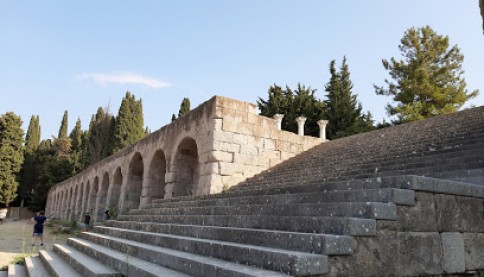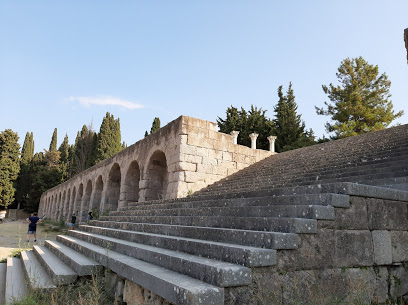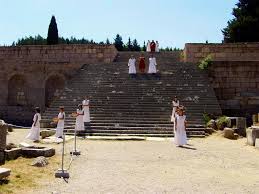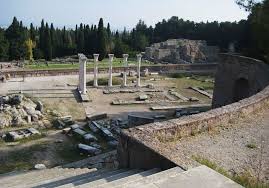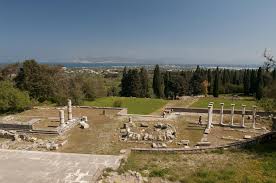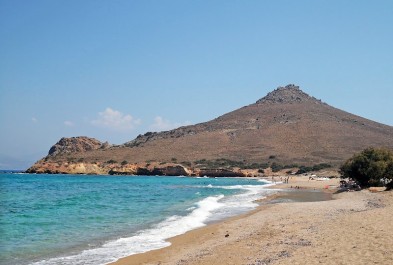Asklepion Kos #77
- Purpose
- Amusement
- Type
- Archaeological site
- Country
- Greece
- City
- Kos
Share links
Description
Asklepiio, built on the slopes of a low hill, overgrown with trees and with a wonderful view of the sea and the Asia Minor coast, was already from ancient times the most famous monument of Kos.
It was located close to the ancient city and was full of wonderful votives, works of famous artists, as very vividly described to us by the Kos poet Herondas in the 3rd century. e.g. and Strabo, a little later (14.2.19).
In contrast to the sanctuary of Asclepius in Epidaurus, in Asclepius of Kos scientific medicine was especially developed, thanks also to the school founded on the island by Hippocrates, one of the most important representatives of medical science in antiquity.
The earliest use of the site dates back to the Mycenaean and Geometric eras, as evidenced by finds that come mainly from tombs. In the following centuries in the area there was worship of the healing demon Paion, and of Apollo, father of Asclepius. Apollo, in fact, bore the name Kyparissios, because he was owner of the sacred grove of cypress trees, which surrounded the mosque and was protected by a sacred law.
Other gods of the Koos were also worshiped in the area, such as Zeus Ikesios, Zeus Patroos, Zeus Michaneus, Athena Fatria, Apollo Karneios and the Fates, while in the 4th c. B.C., at the time of the foundation of the city of Kos, the cult of Asclepius was included, which emerged as one of the most important public cults of Kos during the 3rd and 2nd centuries. e.g. Then the sanctuary was designed and developed as a single complex of buildings with the aim of promoting the worship of Asclepius and gradually expanded to three halls. The center of worship was originally an altar from the middle of the 4th century. BC, in the middle man. At the beginning of the 3rd c. e.g. the gallery of the lower hall was shaped, an Ionic temple dedicated to Asclepius was built and an altar for the burial of the faithful in the middle hall, while a higher, third hall was also created. The sanctuary enjoyed great prosperity in the Hellenistic and Roman times and acquired pan-Hellenic fame, especially after 242 BC, the year in which the Koos secured the recognition of immunity, i.e. the protection of the sanctuary from war or other hostile actions, and established the Great Asklepiia, a five-yearly festival, during which musical and nudist competitions were held, in which all Greek cities participated. In Kos, as in the rest of Asklepiia, initially the traditional treatment was followed, based on the miraculous intervention of the god, who appeared in the dreams of the patients and indicated their treatment when they fell asleep in a special area of the sanctuary. This practice was observed at least during the Hellenistic era, while later it seems that there were professional doctors who treated the faithful using more scientific methods.
At the beginning of the 2nd c. e.g. the Asclepius was placed under the protection of King Eumenes II of Pergamum and then acquired its current monumental appearance. A larger, imposing central staircase was built, leading to the upper hall, in the center of which was built a large Doric temple dedicated to Asclepius, a copy of the Epidaurus temple. In the same period, Doric arcades with rooms for the patients were built on the three sides of the hall, replacing the older wooden galleries, the old altar of Asclepius was reconstructed in the middle hall, in the style of the altar of Zeus of Pergamum, while in the lower hall the monumental entrance-propyla to the sanctuary. In the 1st century m.X. the toilets, the so-called Vespasians, a large complex of thermal baths, the temple dedicated to Asclepius, Hygeia and Hepione, and a library were built. The thermal baths and the water supply were donated by the famous Greek physician Gaius Stertinius Xenophon, who lived in Rome and was the personal physician of the emperors Tiberius, Claudius and Nero, while the temple and the library were his own donations. At the time of the Antonines, the 2nd c. A.D. the Corinthian temple of Apollo was built, while in the 3rd c. m.X. added thermae on the east side of the lower manor. The site continued to function until late antiquity, as indicated by a hoard of coins from the 4th c. A.D. and was abandoned after the earthquakes that occurred in 469 and 554 AD.
In the early Christian years, the church of Panagia Tarsos, a member of the Patmos monastery, was founded on the pavilion of the ancient temple, from which only a capital that served as the Holy Altar survives. The name Tarsus is believed to be a corruption of the words "of the grove", referring to the grove of cypresses, in which Apollo Cyparissius was originally worshipped. Later, the Knights of the Order of St. John of Jerusalem used architectural members of the sanctuary as building material for the construction of the medieval castle.
Searches for the location of Asklepiion began already at the end of the 19th century. The sanctuary was discovered at the beginning of the 20th century, in the period 1901-1905, by the German archaeologist R. Herzog following the suggestion of the Koos historian Iakovos Zarraftis. The abundance of architectural members and inscriptions as well as the proximity to the source of Vourinna and Kokkinoneros, which supplied the sanctuary with water necessary for the treatment of the sick, led to the selection of the site for conducting the excavation research. In the 1930s, Italian archaeologists excavated the site, who restored the monuments, giving the sanctuary its current form.
The space of the Asklepiion is formed in three continuous towers, connected to each other by imposing monumental staircases. Access to the sanctuary was by an impressive staircase through a large four-columned propylon, which led to the lower anderis, a kind of courtyard or square, which was the place where the sick were treated. The manor was flanked on the north, west and east sides by a P-shaped Doric portico, from the Hellenistic era (3rd century BC), of which only the foundations are visible today. At the back of it were opened rooms and auxiliary spaces for pilgrims and patients. The south side of the tower is defined by the retaining wall that holds the second tower. Niches were created in this wall during Roman times, where statues, fountains with thermal waters and water tanks were placed, one of which still includes a spring and tank. From these fountains the sanctuary was supplied with water, which came from two sources, Kokkinonero, to the southwest of Asklipieion, with its iron water, and Vourinna, to the southeast, which until today supplies the city. Water must also have flowed in the marble kennels along the arcades, giving the space a sense of coolness. The wall is interrupted by the ascending scale at the middle landing. To the west of it, a niche with a temple-shaped facade is preserved, where there is an inscribed base of a statue, perhaps of Nero, which was assigned to the sanctuary by the famous Koos doctor Gaios Stertinios Xenophontas. At the ends of the parapet wall, two wide passages were formed in the lower hall, as the lateral ends of the portico did not reach the wall. At the western end of the portico are preserved toilets, the so-called Vespasian ones, which date back to the 1st century. AD, while to the east of the portico a complex of Roman baths of the 3rd c. m.X., consisting of three rooms with arches on the narrow sides, for the cold and hot baths, where remains of frescoes and mosaic floors are preserved.
In the middle floor are the buildings that mainly served the religious needs of the sanctuary, placed in the space with a relaxed and free layout. A central position is occupied by the remains of the great altar of Asclepius, which was originally built in the middle of the 4th century. p.X. and is the oldest building of the sanctuary. Its sculptural decoration, of which almost nothing survives, is thought to have been the work of Praxiteles' sons. To the west of the altar is an Ionic two-style temple in parastasis (on the facade a portico of two columns between parastases), dedicated to Asclepius, of the 3rd c. p.X. The base of the cult statue is preserved, as well as a pit in the floor of the nave, which has been interpreted according to epigraphic evidence as the treasure of the temple, i.e. the place where the money and sacred utensils of the sanctuary were kept. To the south of the temple is a two-sided building with a Doric four-columned pediment, which is considered the residence of the priests or "avato", i.e. the place where the sick lay down waiting for God's healing. To the east, a semi-circular platform for placing statues, a fountain and a Roman temple pavilion from the 2nd c. AD X., Corinthian style, probably dedicated to Apollo, father of Asclepius and former owner of the sanctuary.
Between the porch and the platform there is the monumental staircase that leads to the third, upper floor. The large Doric temple of Asklepios, from the 2nd century, dominated here. BC, copy of the temple of Epidaurus. Its entrance was directly opposite the top of the stairs. A church named Panagia Tarsou was built under his patronage during the first Christian times, from which only a capital that served as the Holy Altar survives today. To the south, west and east, the andiro closes a P-shaped Doric portico, which dates back to the 2nd century. e.g. and had rooms at the back for the pilgrims and the sick.
D. Mposnakis, Archaeologist
E. Skerlou, Archaeologist
Indoor amenities
Route to location
Multimedia
Image gallery
Your Review
Please login or register to write your review
Reviews
No reviews found, be the first!


